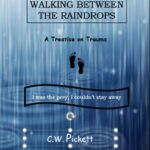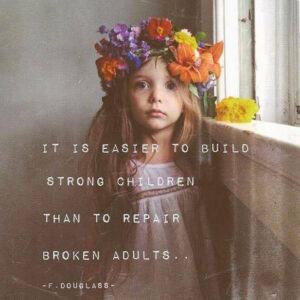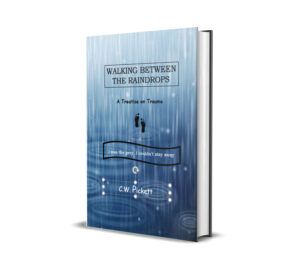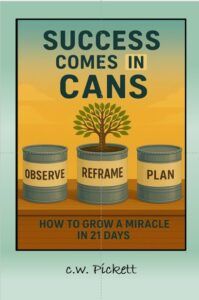
SUCCESS COMES IN CANS
Feeling stuck is a common feeling for many of us. We are in a job we hate, in a relationship going nowhere, cannot seem to get of the couch and get motivated to do anything useful.
It is a horrible feeling to live a life you are not happy with. We search for answers, take self-help courses, go to counselling, pray, meditate, some of us reach for that addicting habit just to soothe our angst.
This feeling of stuckedness is not just in your head. There are many reasons you feel the way you do, but as they say:
The only way out is to face your reality and work through it.
You work through it, and still no results. You are still stuck.
Well, Success Comes in Cans, How to Grow a Miracle in 21 Days is not just another self-help book. Most books read well, give you some ideas to grow, but after a while the old ways kick in, and that advice becomes a memory.
I am here to offer you a different way to go about solving your problems.
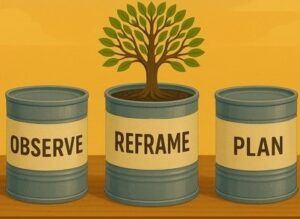
As you see, here is a money tree growing in a can labeled “reframe”, flanked by two other cans labeled “observe” and “plan.”
This is how you grow a miracle.
This is how you become unstuck. This is how you get off the couch, or wherever you are stuck. This is how you achieve your dreams.
21 days, you say. How do you grow a miracle, anyway?
You take a problem, and you spend 7 days observing your thoughts about that problem. What do you do on the couch all day? How does that make you feel? Are you depressed? Obviously stuck in a rut, what keeps you there?
Week 1 – Observe
The first week, observe. No judgement, no changes. Just be a witness to your day.
The second week, you reframe those thoughts. You have a pretty good idea why you remain where you are, how it makes you feel, and any limiting beliefs that keep you there.
Keep a journal so when you go back and read what you wrote, you will see patterns, good and bad, and gather clues on where you can improve.
Take those limiting beliefs and rewrite them. From the first week, you discovered where they are coming from – what voices in your head – and from your past – are repeating those ideas. Now you get to challenge them – perhaps for the first time in your life. If you think you are worthless, by the time you finish this book, you will say “I AM POSSIBLE.”
The worst emotional pain people feel is rejection.
A social pain equivalent to a heart attack. A social heart attack, if you will. Your brain doesn’t know if the pain is from a real heart attack or a broken heart, all it knows is there is pain, and its job is to alleviate it. So then we go into these self-blame theories – it must be me, I am worthless because no one loves me.
People who have been traumatized have these thoughts. Most of us have been traumatized. Few of us grow up with a stress-free, 100% loved-filled childhood. Life is traumatic, no matter how hard you try to keep the demons away. It is bound to bite you on the backside some time in your life.
Unless you have a solid system of “I am worthy,” those setbacks reinforce what you have believed all along. “I am worthless.”
Week 2 – Reframe
In week two, you reframe these thoughts. You are not worthless. By reframing your thoughts, your habits automatically reframe as well. Once you see you are not worthless, your confidence grows.
Week 3 – Plan
By week three, after agonizing over and examining the problem you want to solve, you come up with a plan. What will it take to get off the couch? Do you need to see a counsellor. Or a doctor. Perhaps you are ill. Perhaps all you need is a buddy to cheer up your day!
But the point of this 21-day miracle, is by day 21, believe it or not, you will say, “It’s a miracle.” If nothing else, you will say, “I did it, I made it through!” That in itself is a miracle, especially if you are prone to giving up halfway through.
Making the 21 days gives you confidence that you can complete a task, no matter how small or mundane.
I use this process all the time. It gives me a time frame to think about what’s bothering me and a way to come up with some plausible solutions to my problems. This works with getting your finances in order, shedding those unwanted pounds, finding a better job.
This is not to say your world will completely change in 21 days, but that is a possibility. This is also not to say you will shed all of your weight – or even find a better job in 21 days. But it is to say, the 21 days has got you thinking, and if you have a plan, you know where to go from here.
And if you need another session, try another 21 days. You’ll find better insights and come up with different solutions.
This is not heebie-jeebie stuff, folks.
This is the best thing I’ve found to getting out of my ruts. Perhaps it is because it is time sensitive. Perhaps it is because it delves deep into your thinking patterns and gives you a chance to face your shadow and your fears. For many of us, being able to do just that is in itself a miracle.
I am curious if it works for other people as well as it works for me. Read the book and let me know in the comments if you became unstuck. It’s only 21 days. What can you lose?
![]()

